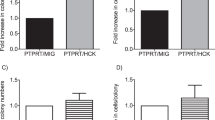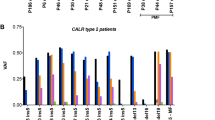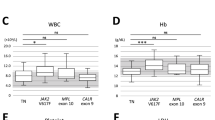Abstract
Polycythemia vera (PV) is an acquired clonal disorder characterized by increased production of mature red cells and growth of erythroid colonies in the absence of erythropoietin. Mutation of the erythropoietin receptor has been demonstrated to cause familial polycythemia, but no mutations have been found in PV. Moreover, both erythroid and myeloid progenitors from patients with PV have been reported to be hypersensitive to a number of different growth factors. Attention has therefore focused on post-receptor signal transduction pathways. The SHP-1 gene is an especially attractive candidate gene. Firstly, SHP-1 binds to and negatively regulates signalling from the erythropoietin receptor and is likely to regulate other cytokine receptors in a similar manner. Secondly, absence of SHP-1 protein in the motheaten mouse is accompanied by increased sensitivity of hematopoietic progenitors to a number of cytokines including erythropoietin. Thirdly, familial or sporadic polycythemia in man may result from mutations of the SHP-1 binding domain of the erythropoietin receptor. We have therefore searched for mutations of the SHP-1 gene in genomic DNA from patients with PV. In this disease the majority of peripheral blood lymphocytes are not part of the malignant clone and a variable proportion of myeloid cells may arise from normal progenitors. We have therefore chosen to study DNA from purified peripheral blood granulocytes obtained from nine women in whom the granulocytes were clonally derived. Southern analysis was used to show that the gene was not rearranged and densitometry confirmed the presence of two copies of the gene in each DNA sample. Sequencing of the entire coding region and all splice junctions revealed no mutations. Hematopoietic transcription factor binding sites in the SHP-1 promoter region were intact and the methylation status of the two SHP-1 promoters in PV patients was identical to that in three normal controls. Finally, we showed that levels of SHP-1 protein in granulocytes from patients was similar to those from normal controls. These results demonstrate that the SHP-1 gene is structurally and transcriptionally intact in patients with PV.
This is a preview of subscription content, access via your institution
Access options
Subscribe to this journal
Receive 50 print issues and online access
$259.00 per year
only $5.18 per issue
Buy this article
- Purchase on Springer Link
- Instant access to full article PDF
Prices may be subject to local taxes which are calculated during checkout
Similar content being viewed by others
Author information
Authors and Affiliations
Rights and permissions
About this article
Cite this article
Asimakopoulos, F., Hinshelwood, S., Gilbert, J. et al. The gene encoding hematopoietic cell phosphatase (SHP-1) is structurally and transcriptionally intact in polycythemia vera. Oncogene 14, 1215–1222 (1997). https://doi.org/10.1038/sj.onc.1200942
Received:
Accepted:
Issue Date:
DOI: https://doi.org/10.1038/sj.onc.1200942
Keywords
This article is cited by
-
Tyrosine phosphatase SHP-1 in allergic and anaphylactic inflammation
Immunologic Research (2010)
-
Macrophages of multiple sclerosis patients display deficient SHP-1 expression and enhanced inflammatory phenotype
Laboratory Investigation (2009)
-
SHP-1 deficiency and increased inflammatory gene expression in PBMCs of multiple sclerosis patients
Laboratory Investigation (2008)
-
Genetic complexity of myeloproliferative neoplasms
Leukemia (2008)
-
The Pathogenesis of Chronic Myeloproliferative Diseases
International Journal of Hematology (2001)



